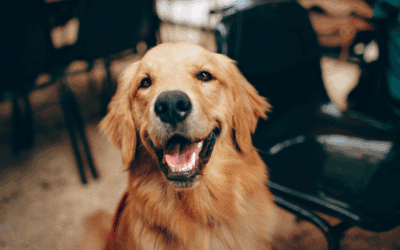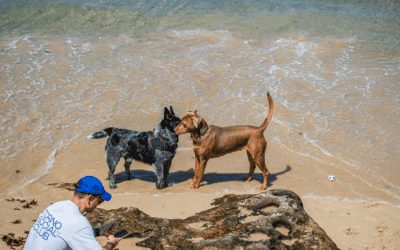Disclaimer: Kate’s K9 Pet Care proudly provides dog walking, cat sitting, small animal pet care, pet taxi services, “Almost Overnight” pet care, and convenient pet supply delivery.
For full details about each of our services, please visit our Service Pages to learn more about how we can support your pet’s needs. To see where we currently operate, please visit our Service Area Page.
Why is your dog giving you the dog side eye? What happens when your canine companion throws you a glance that’s more of a sidelong ‘look’ than a definite stare?
Dog side eye, that now-famous googly-eyed expression of suspicion, curiosity, or side-splitting canine sarcasm, is a phenomenon that’s more than just funny dog side eye memes — it’s a mode of communication deeply embedded in the language of dog.
In this exploration, we’ll dissect the silent cues that your four-legged friend so eloquently dispenses with its glances, unlocking the enigma of the dog side eye.
Need Pet Care Fast?
Submit an Instant Service Request today and we’ll take care of the rest.
Understanding Dog Body Language
When your dog glances at you out of the corner of its eye, it can speak volumes about their state of mind. This subtle body language, often referred to as the ‘whale eye’ when the eyes are wide and the whites are showing, looking like a half moon eye signals a level of discomfort or unease.
It’s a defensive mechanism and can be a prelude to aggressive behavior, or simply an indication that the dog is in a situation it finds uncomfortable.
The interpretation of side eye largely depends on the context; analyzing the entire body language of the dog is crucial for the most accurate reading.

Factors Influencing Dog Side Eye
Dogs might throw a side eye for various reasons. While it can signal that your furry friend is feeling tense or uncertain, the environment and the dog’s mood can tip the scales of interpretation.
A dog feeling cornered or physically restricted may resort to giving you the side eye as an attempt at defusing a possible confrontation, while in a more relaxed setting it could be a fleeting curiosity — or even a playful invitation.
Understanding the nuances can help you tell the difference between a sign of distress and a simple, albeit quirky, look from your pet.
Mood and Intentions
A dog’s intentions are not always easy to discern, especially through the nebulous realm of other body language cues.
Aggression, playfulness, wariness— these are all moods that can be behind the side eye. Tracing the way the dog’s body moves alongside the glance is key to understanding the message being sent.
Environmental Stimuli
The context in which a side eye is given is vital. A dog may be wary of a new addition to the household or other dogs, and other household items such as a vacuum cleaner, or may be expecting punishment due to a broken vase.
Recognizing what has triggered this response is crucial for a well-informed interpretation.
Is your dog giving you the side eye because they want Kate’s K9 Pet Care to come and take them on an exciting walk while your working? Well contact us today!

The Science Behind Dog Expressions
What lies at the root of dog’s expressions such as the side eye? With a history of co-evolution and close companionship with humans, dogs have developed a sophisticated range of behaviors to interact with us.
Studies in anthrozoology and dog behavior have shed light on the possible evolutionary reasons for their expressions, suggesting that these nonverbal cues are involved in survival strategies, social hierarchies, and pack cohesion.
Behavioral Studies
Scientists have long been intrigued by the expressive nature of dogs. Observational studies in psychology and animal behavior have laid the groundwork for understanding how dogs communicate with each other — and us.
This work has contributed to demystifying the subtle signs in dog behavior that convey so much.
Evolutionary Reasons
With dogs originating from wolves, evolutionary biologists look for explanations in the social structures of canines.
Side eye, for instance, might have been an adaptive behavior in the wild to signal submission or intention to avoid conflict within the pack. This has likely carried over into domestication, where dogs use this form of body language to communicate with humans.
Cultural Perceptions
While dog side eye transcends language barriers, its cultural interpretations can vary. In some cultures, the expression might be endearing and comical, while in others, it could be seen as a sign of a menacing intent.
Internet memes and viral videos have served to globalize the appeal and relatability of the dog side eye, often portraying it in a light-hearted, humorous context.
Media Representation
From movies to marketing, dog side eye has made its way into the litany of dog portrayals in the media.
This continuous portrayal affects the public perception and interpretation of the expression, sometimes simplifying or exaggerating its facets for entertainment value.
Cross-Cultural Comparisons
Different cultures bring different perspectives on the behavior and significance of dog side eye. Travel the world, and you may find that the subtle cues your dog gives off are perceived in vastly different ways.
It’s a reminder that while there’s universality in the love for dogs, the context of their communication can be highly contextual.

Practical Tips for Dog Owners
Witnessing your dog’s side eye can raise questions about how to respond or whether there’s a need for concern. Knowing how to read and appropriately react to your dog’s body language is essential for fostering a strong human-canine bond.
Responding to Side Eye
When your dog gives you the side eye, how you respond can make a significant impact on its behavior and the mutual understanding between you.
Avoid staring back in the dog’s eyes or making eye contact, as this can be perceived as confrontational. Instead, guide your behavior based on why you think your dog might be of two minds about something.
Building Trust and Communication
Understanding your dog’s side eye is just one element of building a trusting and expressive relationship with your pet.
Engaging in positive reinforcement training, incorporating regular exercise, and spending quality time together can help in conveying to your dog that side eye or not, it’s understood and valued.

Managing Dog Overstimulation in Public Places
Now that we have went over the general knitty gritty of the dog side eye, we thought it would be important to include a section to educate on dog behavior in public places and how to recognize signs.
In public places, dogs can easily become overstimulated due to the overwhelming abundance of stimuli — from the hustle and bustle of crowds to unexpected noises and the presence of other animals.
Overstimulation can lead to anxiety, discomfort, and even reactive behavior in dogs, posing risks to both the dog and surrounding people. Recognizing and preventing overstimulation is crucial for ensuring the safety and well-being of your pet and the public.
Signs of Overstimulation
Being attuned to the signs of overstimulation in your dog is the first step to managing it. These signs may include excessive panting, drooling, barking, or whining, showing reluctance to move, or attempting to hide.
A dog displaying whale eye or side eye, as discussed earlier, might also indicate feelings of stress or being nervous or overwhelmed.
Strategies for Prevention
-
Frequent Breaks: Regularly scheduled breaks in a quiet area can allow your dog to calm down and reset.
-
Desensitization Training: Gradually exposing your dog to busy environments while ensuring positive experiences can help them become more comfortable in such settings over time.
-
Monitoring Play: In dog parks or social situations, keep a close eye on play dynamics. Intervene if play becomes too rough or if your dog seems to be getting overly excited.
-
Providing an Escape Route: Always plan an exit strategy. If your dog shows signs of distress, knowing how to quickly and calmly leave the situation can prevent escalated stress or potential aggressive outbursts.
The Dangers of Overstimulation
When dogs become overstimulated, their ability to process information and make “good decisions” diminishes. This state can lead to unwanted behaviors such as jumping on people, barking uncontrollably, or even snapping at perceived threats.
In settings with children, other pets, or crowded areas, these reactions pose a liability and can result in physical harm or emotional trauma to both people and the dog.
By understanding and managing the signs of overstimulation, dog owners can ensure that outings remain enjoyable and safe experiences. This proactive approach not only safeguards the well-being of the dog but also contributes positively to public safety and the perception of dogs in community spaces.

Other Funny Dog Facial Expressions
To end this blog on a funny note we will talk about a range of other facial expressions that often amuse and delight their human counterparts. These expressions, ranging from the “zoomies” face to the infamous “guilty” look, offer a glimpse into the rich emotional lives dogs lead.
The “Zoomies” Face
This expression is often seen when a dog is about to engage in a frenetic burst of energy, known as the zoomies. Their eyes widen, ears perk up, and sometimes, a goofy grin spreads across their face, signaling the impending whirlwind of excitement. This expression is a testament to the joy and spontaneity dogs bring into our lives.
The Guilty Look
Perhaps one of the most recognized dog expressions is the “guilty” look. This usually involves averted eyes, a slightly lowered head, and occasionally, the classic “puppy dog eyes.” While research suggests this look is more about the dog’s response to being scolded than actual guilt, it remains a humorous and heartwarming display of canine emotion.
The Head Tilt
The head tilt, characterized by a dog’s inquisitive tilting of their head to one side, often elicits smiles and laughter from dog owners.
This endearing action is thought to help dogs hear better or see our faces more clearly, but it also serves as a moment of pure charm, inviting us into a silent conversation of curiosity and affection.
These expressions and more enrich the lives of dog owners daily, providing a window into the complex world of canine emotions. By learning to interpret and appreciate these funny facial expressions, we deepen our connection with our furry friends, celebrating the joy and nuance they bring to our lives.

Conclusion
The dog side eye, a nuanced expression that has captivated dog owners and enthusiasts alike, is a window into the soul of your pet.
It melds a rich interplay of emotions, intentions, and contextual cues that invite a deeper understanding. Whether serving as a lighthearted source of humor or a serious signal of unease, dog side eye is but one facet of the intricate tapestry that is dog body language.
In the merry dance of living with dogs, where they learn as much from us as we do from them, the side eye can be a reminder to stay attuned to the subtler notes of their silent language. By interpreting it with care and context, we honor the timeless conversation dogs and humans share — one sideways glance at a time.







